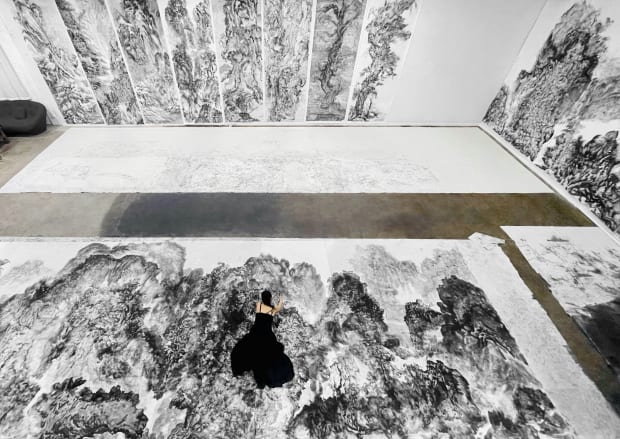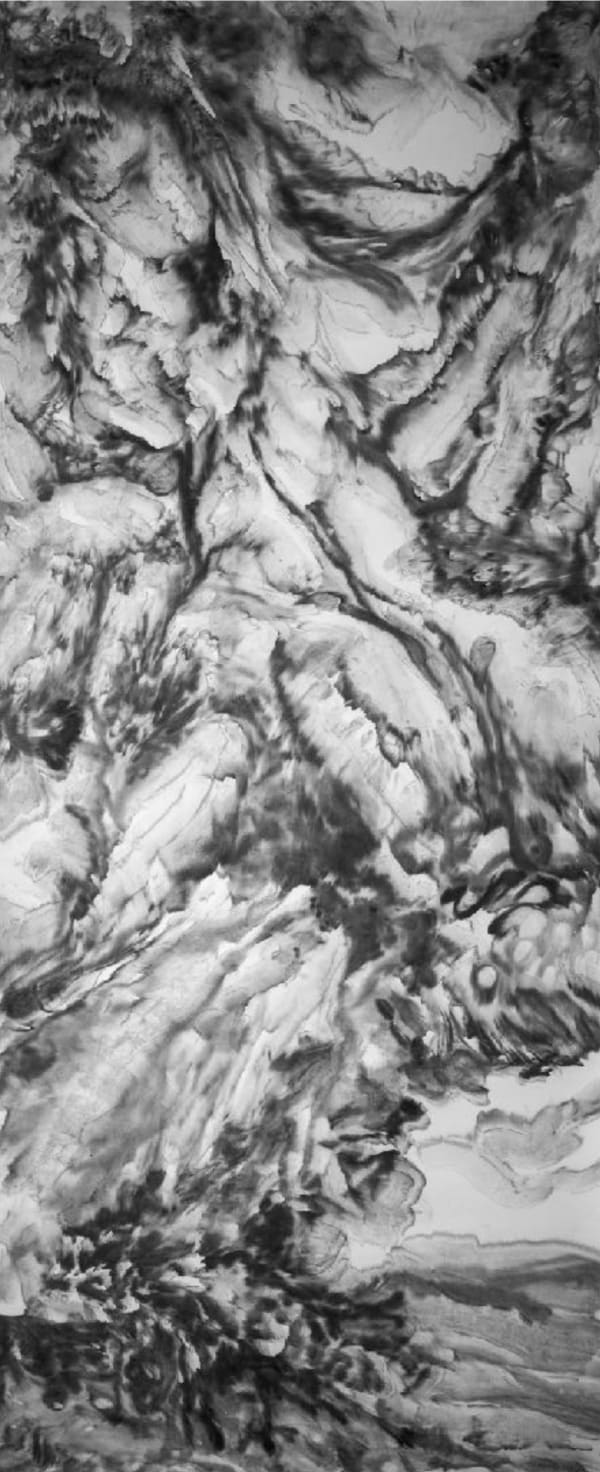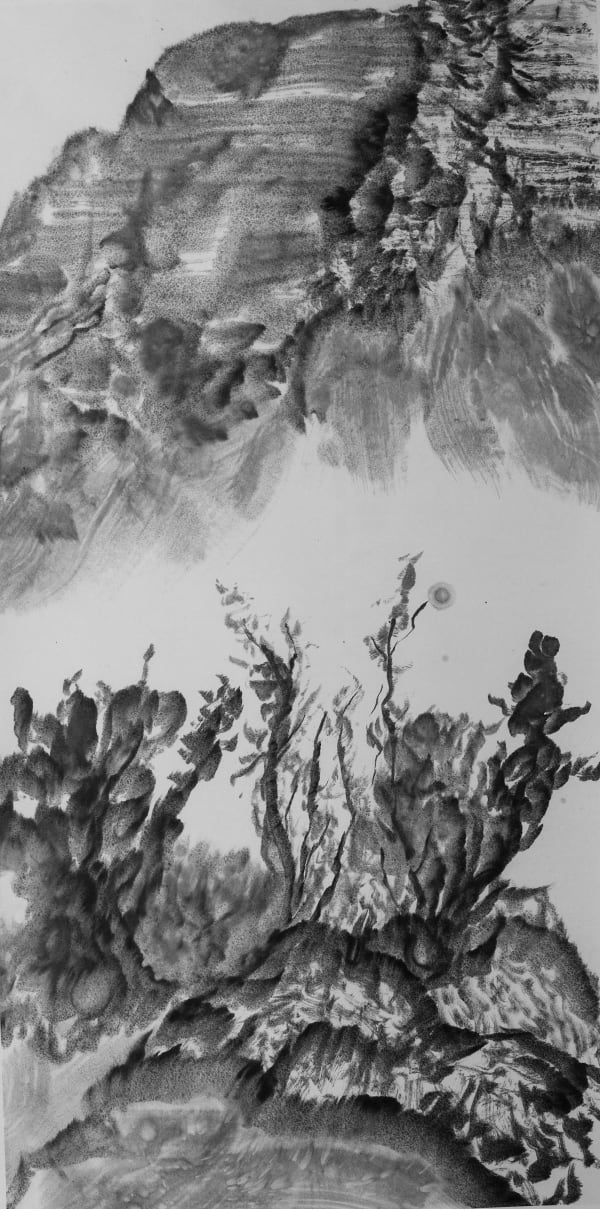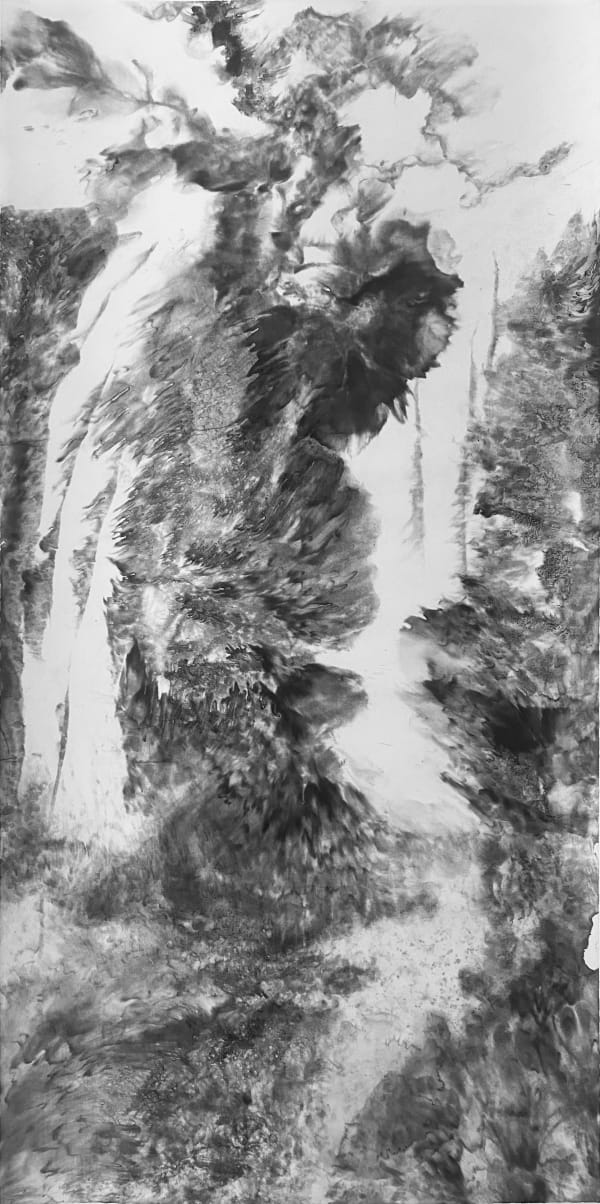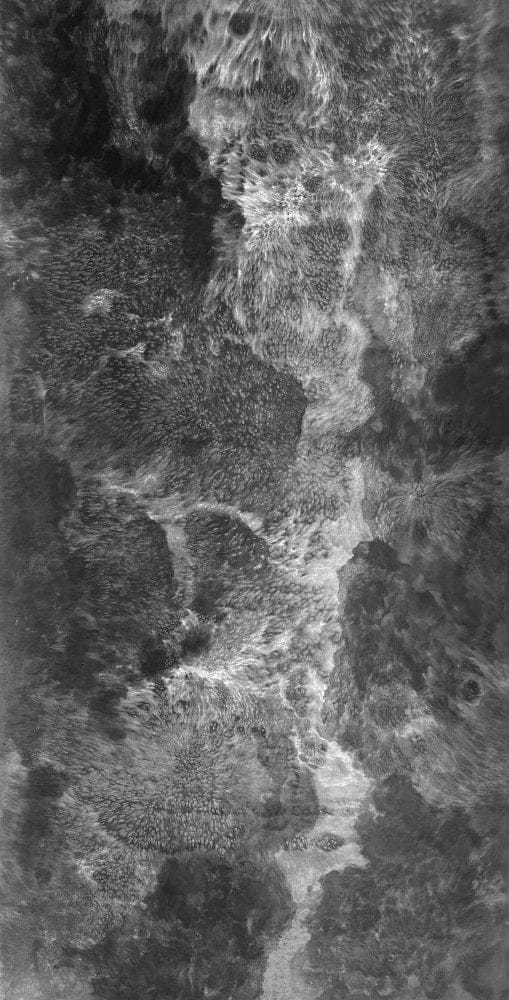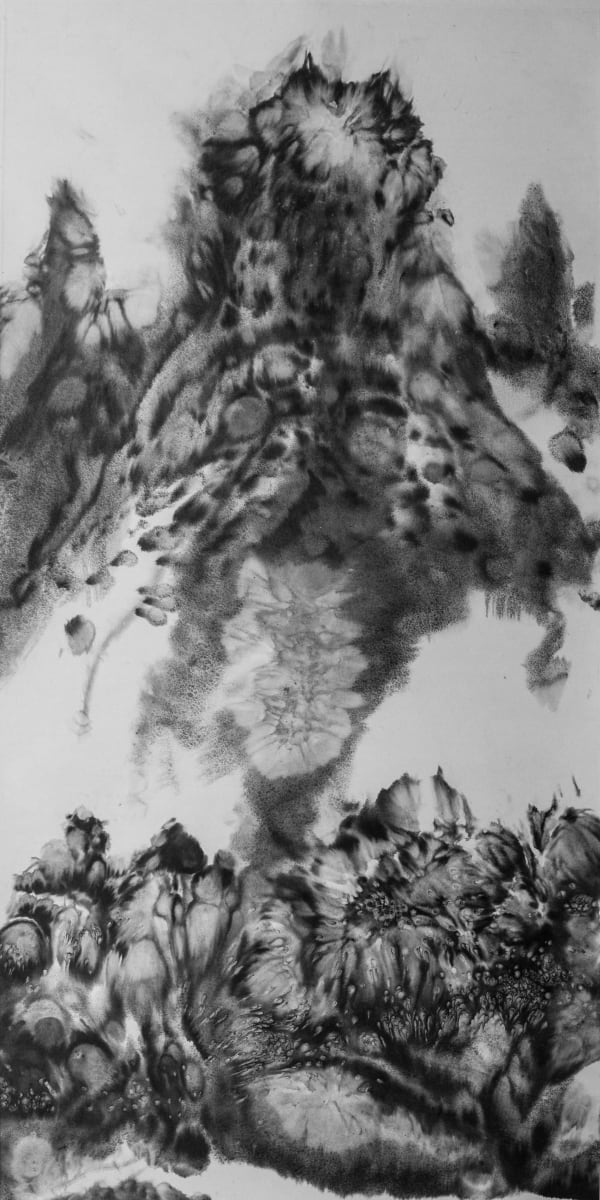-
Curator: Britta Erickson, Ph.D.
Dates: November 18, 2023 – February, 25 2024
-
BINGYI: The Eyes of Chaos
The emperor of the South Sea was called Shu [Brief], the emperor of the North Sea was called Hu [Sudden], and the emperor of the central region was called Hun-tun [Chaos]. Shu and Hu from time to time came together for a meeting in the territory of Hun-tun, and Hun-tun treated them very generously. Shu and Hu discussed how they could repay his kindness. "All men," they said, "have seven openings so they can see, hear, eat, and breathe. But Hun-tun alone doesn't have any. Let's trying boring him some!"Every day they bored another hole, and on the seventh day Hun-tun died.——ZhuangziINKstudio is proud to announce the opening of Bingyi's third solo exhibition at the gallery entitled "Bingyi: The Eyes of Chaos." An artist, architectural designer, curator, cultural critic, and social activist, Bingyi has developed a multi-faceted practice that encompasses land-and-environmental art, site-specific architectural installation, musical and literary composition, ink painting, performance art, and filmmaking. In "The Eyes of Chaos" INKstudio will debut Bingyi's latest grand, speculative narrative about Art and its relationship to Nature, Literature, History and Politics as retold or reimagined from a woman's point of view.
Bingyi tells her story through two bodies of work resulting from her investigations over the past five years into the origins of the ink monochrome landscape in China: The Eyes of Chaos: Temple of the Matriarch of Painting —— the organic development of Bingyi's land-and-environment art practice into historical landscape painting; and Dream within a Dream within a Dream —— a speculative, archaeological reconstruction of the life of Hua, the "Matriarch of Painting." Hua, it turns out, was not only a visionary woman artist but a philosopher and political thinker who, in the Northern Song, created an alternative aesthetic system that de-centered the Patriarchal, Confucian, Brush-centered and Humanistic mode of literati landscape painting and, from a Woman's point of view, re-centered the expressive possibilities of brush and ink on Ink and Water, on Taoism and on Nature.
Bingyi: The Eyes of Chaos is the worldwide debut of Bingyi's speculative grand narrative about the life of Hua, Bingyi's Matriarch of Painting. The Eyes of Chaos: Temple of the Matriarch of Painting is the premier of Bingyi's Taihang series landscapes in China and the first time Bingyi's complete vision for the Taihang temple installation will be fully realized. A smaller version of this installation was debuted at the Philadelphia Museum of Art in 2022 by curator of Chinese art and head of the East Asian Art department, Hiromi Kinoshita, an earlier four-panel composition of the Taihang Mountains was exhibited at the Asia Society in Houston in 2023 by independent curator and scholar, Susan Beningson, and a full version of the installation has been selected for a forthcoming solo exhibition for the artist at a major North American Museum of modern and contemporary art.
-

Bingyi painting Taihang Rhapsody, 2022.
-

-
Temple of Hua the Matriarch of Painting
-

-
In the first room to the exhibition, one then encounters the biography of Hua, the Matriarch of Painting, in the form of a long handscroll. The first panel in her biography is a page from the archaeological report documenting the discovery of the Temple. In it, we learn that there are six major spaces in the Temple that correspond to the six major galleries in the exhibition: Hua's Entry Hall, Hua's Temple, Hua's Study, Hua's Meditation Room, Hua's Chamber of Dreams, Hua's Hall of Music. According the texts and the artifacts that follow, Hua was born in 1156, the year after the death of Li Qingzhao (1084 - 1155), China's greatest female poet. Was Hua the reincarnation of Li Qingzhao as China's greatest woman painter, lost to history until this extraordinary discovery? Furthermore, among the discovered texts were writings such as the "Sutra of Madness" that had only recently been recovered through research on the long-lost Lotus Dynasty. Philological research then confirmed a stunning discovery: Hua was not only the Matriarch of Painting but also the spiritual founder of the Lotus Dynasty —— "a utopian society that exists in a slip of time after the Southern Song where wars are fought not with weapons but with poetry, where rivers flow with fragrance instead of water, and where the capital city contains not palace buildings but only mountains and streams filled with music."
In addition to Hua's Biography Scroll, we also encounter three of the four landscape paintings that Hua painted to reflect the four stages of her life, and the very first monumental ink monochrome landscape that she painted of the Taihang Mountains which she aptly titled Chaos Opens.
-
The Eyes of Chaos
-
In the main gallery on the first floor, one then encounters a monumental ink-monochrome landscape painting installation entitled The Eyes of Chaos. Created during Bingyi the artist's 2020-2023 research trips to the Taihang Mountains in Northern China's Eastern Yellow-River Loess. The installation is modeled on Northern Song temple architecture and Bingyi imagines her Taihang series landscapes as the architectural paintings in the Temple of the Matriarch of Painting. The birthplace of Fan Kuan (c. 960 - c. 1030), Guo Xi (c. 1020 - c. 1090), and Li Tang (c. 1050 - 1130) —— three ink painters of the Song Dynasty (960 - 1279) who defined monumental landscape painting practice, the Taihang Mountains are both the historical and spiritual birthplace of the Chinese landscape painting tradition .
The central masterwork of Bingyi's Taihang series is the four-panel masterwork The Eyes of Chaos: Dharma, 2021-2022, flanked on one side by Taihang Rhapsody, 2022-2023, a truly monumental and immersive eight-panel work 3.7 meters high and 12 meters wide, on the other side by single panel landscape compositions inspired by the real Taihang landscape —— as in Secluded Forest in Flying Waterfalls 幽林飞瀑图 —— and by ancient masterworks lost to history —— as in Cold Mountains in Dancing Snow 寒山飞雪.
From a distance, Bingyi's Taihang landscapes exhibit all of the qualities of solid form, spatial depth and resonant space that one expects in a traditional landscape. However, seen up close, all of Bingyi's forms dissolve into formless and chaotic, fluid movement. In her approach to landscape, she returns not to the Northern Song but to the Five Dynasties Period (907 - 960) specifically to Jing Hao (c. 855 - 915). In his seminal text the Bifaji or "Notes of Brushwork", Jing Hao challenges the artist to transmit the character and movement of universal qi energy in nature through the vital qi energy of the artist's mind and body to the aesthetic qi energy of the painting through the spontaneous use of brush and ink. For Jing Hao, the brush must move freely and naturally and ink, when applied properly, should make any trace of brushwork imperceptible. -
Hua’s Study and Meditation Room
-
Off of the main corridor, one will find Hua’s study where Bingyi has installed a gold screen painting of the site in the Taihang Mountains where Hua’s Temple was hidden. On the walls of Hua’s Study, Bingyi has hung additional pages from the archaeological report on the discovery of Hua’s Temple. Inside Hua’s Study, one then encounters her darkened Meditation Room where one will find her most refined, fine-line baimiao Landscape Fairy paintings, her poetry-inspired fine monochrome landscapes on silk and her monumental Tea Sutra —— a philosophical meditation on the creation of the universe as experienced in a single sip of tea.
-
-
 Bingyi 冰逸, Map of the Sacred Mountain《圣山图》——考古地图, 2019-2023
Bingyi 冰逸, Map of the Sacred Mountain《圣山图》——考古地图, 2019-2023 -
 Bingyi 冰逸, Mountain and Water as Encounters 山水如林, 2019-2023
Bingyi 冰逸, Mountain and Water as Encounters 山水如林, 2019-2023 -
 Bingyi 冰逸, Mountain and Water as Clouds 山水如云, 2023
Bingyi 冰逸, Mountain and Water as Clouds 山水如云, 2023 -
 Bingyi 冰逸, Mountain and Water as Rocks 山水如石, 2019-2023
Bingyi 冰逸, Mountain and Water as Rocks 山水如石, 2019-2023
-
 Bingyi 冰逸, Mountain and Water as Winds 山水如风, 2019-2023
Bingyi 冰逸, Mountain and Water as Winds 山水如风, 2019-2023 -
 Bingyi 冰逸, Tea Sutra 茶经, 2017-2022
Bingyi 冰逸, Tea Sutra 茶经, 2017-2022 -
 Bingyi 冰逸, Landscape Fairies 山水万物, 2019-2022
Bingyi 冰逸, Landscape Fairies 山水万物, 2019-2022 -
 Bingyi 冰逸, Landscape Fairies 山水万物, 2019-2022
Bingyi 冰逸, Landscape Fairies 山水万物, 2019-2022
-
-
Dream within a Dream within a Dream
-
Bingyi's narrative continues on the third floor in Hua's Chamber of Dreams. In this space, Bingyi has installed Dream within a Dream within a Dream —— a trove of paintings and texts by Hua herself recovered by Bingyi, the archaeologist, at the site of the Temple of the Matriarch of Painting. In the Dream Within a Dream Within a Dream scrolls, the Matriarch of Painting creates an exquisite literary, conceptual and architectural complex that reimagines the space-time relationship between various literary traditions over the past two thousand years. Each of the scrolls is a magical allegory drawn from an ancient text. Each scroll starts with a historical remnant or reminiscence, then unfolds into the main narrative scene, and finally completes itself with a final image or poem written in one of the Matriarch's distinctive antique calligraphic styles.
-
-
 Bingyi 冰逸, Dream of the Plum Blossom in Luofu 罗浮梦梅, 2019-2023
Bingyi 冰逸, Dream of the Plum Blossom in Luofu 罗浮梦梅, 2019-2023 -
 Bingyi 冰逸, The Peony Pavilion 牡丹亭, 2019-2023
Bingyi 冰逸, The Peony Pavilion 牡丹亭, 2019-2023 -
 Bingyi 冰逸, Dream of a Pine Tree by Ding Gu 丁固梦松, 2019-2023
Bingyi 冰逸, Dream of a Pine Tree by Ding Gu 丁固梦松, 2019-2023 -
 Bingyi 冰逸, Rhapsody on the Luo River Goddess 洛神赋, 2019-2023
Bingyi 冰逸, Rhapsody on the Luo River Goddess 洛神赋, 2019-2023
-
-
Hua’s Hall of Music
-
In the final gallery, one encounters Hua's Hall of Music where Bingyi has installed on one wall her Archaelogy of Sound paintings that capture the intensive flows of matter and energy in the natural world and the frequencies or sounds at which they resonate, and on the facing wall her Taihang Landscape paintings rendered now on an intimate scale. On the wall in between, hangs the painting Mountain and Flowing Water —— part Sound painting, part Landscape painting, it leads us to know the World and to know our Self and Others through knowing sound.
-
-
 Bingyi 冰逸, Sound of the Empty Valley 空谷传音, 2021
Bingyi 冰逸, Sound of the Empty Valley 空谷传音, 2021 -
 Bingyi 冰逸, Twin Waterfalls 双瀑图, 2022
Bingyi 冰逸, Twin Waterfalls 双瀑图, 2022 -
 Bingyi 冰逸, Archaeology of Waves (6) 波相绘画 (6), 2019
Bingyi 冰逸, Archaeology of Waves (6) 波相绘画 (6), 2019 -
 Bingyi 冰逸, White Clouds and Dark Beasts 白云苍狗, 2021
Bingyi 冰逸, White Clouds and Dark Beasts 白云苍狗, 2021
-
